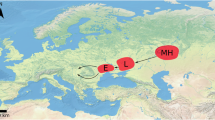Abstract
Recent studies of mitochondrial genes of the head and body lice of humans indicate that present-day lice comprise two lineages that diverged before the evolution of modern humans. To test if this was a locus-specific phenomenon, we studied two nuclear genes, elongation factor-1α (EF-1α) and small subunit ribosomal RNA (ssu rRNA). Our ssu rRNA phylogeny was concordant with the phylogenies from mitochondrial genes, but the EF-1α phylogeny was not concordant either with the mitochondrial phylogenies or with the ssu rRNA phylogeny. So both nuclear (ssu rRNA) and mitochondrial data indicate that there are two lineages of lice: one lineage with head lice only (H-only lineage) the other lineage with head and body lice (H+B lineage). Thus, body lice apparently evolved from just one of the two main lineages of lice. However, the date of divergence and geographical origins of the two lineages are controversial. Kittler et al. (Curr Biol 13:1414–1417, 2003; Curr Biol 14:2309, 2004) proposed that these two lineages diverged 0.77 mya, whereas Reed et al. (PLoS Biol 2:e340, 2004) proposed that they diverged 1.18 mya and suggested that one of the lineages, the H-only lineage, evolved in the New World on Homo erectus. We discuss this hypothesis in light of our results from ssu rRNA.

Similar content being viewed by others
References
Avise JC, Ball RMJ (1990) Principles of genealogical concordance in species concepts and biological taxonomy. Oxf Surv Evol Biol 7:45–67
Castresana J (2000) Selection of conserved blocks from multiple alignments for their use in phylogenetic analysis. Mol Biol Evol 17:540–552
Huelsenbeck JP, Ronquist F (2001) MRBAYES: Bayesian inference of phylogenetic trees. Bioinformatics 17:754–755
Jeanmougin F, Thompson JD, Gouy M, Higgins DG, Gibson TJ (1998) Multiple sequence alignment with Clustal X. Trends Biochem Sci 23:403–405
Jensen-Seaman MI, Deinard AS, Kidd KK (2001) Modern African ape populations as genetic and demographic models of the last common ancestor of humans, chimpanzees and gorillas. J Hered 92:475–480
Kittler R, Kayser M, Stoneking M (2003) Molecular evolution of Pediculus humanus and the origin of clothing. Curr Biol 13:1414–1417
Kittler R, Kayser M, Stoneking M (2004) Molecular evolution of Pediculus humanus and the origin of clothing. ERRATUM. Curr Biol 14:2309
Leo NP, Hughes JM, Yang X, Poudel SKS, Brogdon WG, Barker SC (2005) The head and body lice of humans are genetically distinct (Insecta: Phthiraptera, Pediculidae): evidence from double infestations. Heredity 95:34–40
Leo NP, Campbell NJH, Yang X, Mumcuoglu KY, Barker SC (2002) Evidence from mitochondrial DNA that the head lice and the body lice of humans (Phthiraptera: Pediculidae) are conspecific. J Med Entomol 39:662–666
Posada D, Crandall KA (1998) MODELTEST: testing the model of DNA substitution. Bioinformatics 14:817–818
Reed DL, Smith VS, Hammond SL, Rogers AR, Clayton DH (2004) Genetic analysis of lice supports direct contact between modern and archaic humans. PLoS Biol 2:e340
Steiper ME, Young NM, Sukarna TY (2004) Genomic data support the hominoid slowdown and an Early Oligocene estimate for the hominoid–cercopithecoid divergence. Proc Natl Acad Sci U S A 101:17021–17026
Swofford DL (2002) PAUP*. Phylogenetic analysis using parsimony (*and other methods). Sinauer Associates, Sunderland
Yong Z, Fournier P-E, Rydkina E, Raoult D (2003) The geographical separation of human lice preceded that of Pediculus humanus capitis and Pediculus humanus humanus. C R Biol 326:565–574
Acknowledgement
We thank the following people who collected and/or donated the lice used in this study: Debby Cox, for P. schaeffi (B1387); Maryam Ashrafi, Julio V. Barbosa, L. Breen, Wen Chao, Yin Hong, Arezki Izri, Kosta Mumcuoglu, James Opiyo Ochanda, Ricardo Palma, Renfu Shao, Rick Speare, Cheryl Thomas, Claudia Vassena, Helen Weld and Xiaoye Yang. Dr. Bruce Hayes, Patan Hospital, Kathmandu, Nepal, and Mr. Shree Poudel, Department of Science, Janapriya Multiple Campus, Pokhara, Nepal, who helped SCB collect lice in Nepal. We also thank Anna Murrell for preliminary molecular clock analyses of ssu rRNA data.
Author information
Authors and Affiliations
Corresponding author
Electronic supplementary material
Fig. 2
Phylogenetic trees from elongation factor-1α from P. humanus and P. capitis, with P. schaeffi as the out-group. a Consensus tree from maximum parsimony analysis; b Bayesian tree; c neighbour-joining tree. Sequences marked with * are from Yong et al. (2003); all other sequences are from Kittler et al. (2003). H, head louse; B, body louse
Rights and permissions
About this article
Cite this article
Leo, N.P., Barker, S.C. Unravelling the evolution of the head lice and body lice of humans. Parasitol Res 98, 44–47 (2005). https://doi.org/10.1007/s00436-005-0013-y
Received:
Accepted:
Published:
Issue Date:
DOI: https://doi.org/10.1007/s00436-005-0013-y




